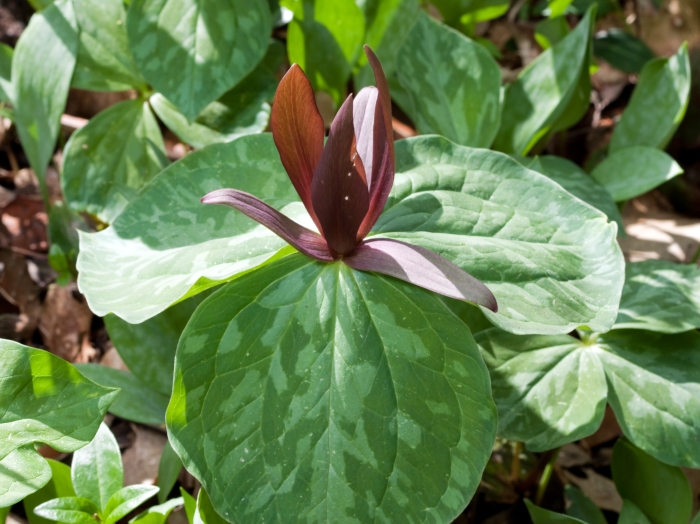Little Sweet Betsy
(Trillium cuneatum)
Little Sweet Betsy (Trillium cuneatum)
/
/

Kaldari
Public domain
Image By:
Kaldari
Recorded By:
Copyright:
Public domain
Copyright Notice:
Photo by: Kaldari | License Type: Public domain | License URL: https://creativecommons.org/public-domain/ | Uploader: Kaldari | Publisher: Wikimedia Commons | Title: Trillium_Nashville.jpg | Notes: Transwiki approved by: [[w:en:User:Dmcdevit]] This image was copied from wikipedia:en. The original description was: {{Move to Commons}} Painted trillium (''Trillium undulatum''). [[w:en:George Washington National Forest]]. Photo by T.G. Barnes. Source |



















































Estimated Native Range
Summary
Trillium cuneatum, commonly known as Little Sweet Betsy, is a deciduous perennial herb native to rich, deciduous forests and wooded slopes in the Southeastern United States. It typically grows to a height of 1-2 feet (0.3-0.6 meters) and a width of 0.8-1 feet (0.2-0.3 meters). The plant features a whorl of three broad, mottled leaves that provide a striking backdrop to its sessile, banana-scented flower. The flowers, which bloom in early to mid-spring, are quite showy with erect petals that can be maroon, bronze, green, or yellow. Little Sweet Betsy is the largest of the eastern sessile-flowered trilliums and is noted for its distinctive mottled foliage and variable flower color.
Little Sweet Betsy is valued for its unique flowers and foliage, which make it a popular choice for shade gardens, woodland plantings, and naturalized areas. It is relatively low-maintenance, requiring medium water and thriving in part shade to full shade. The plant prefers humus-rich, well-drained soil and benefits from a layer of mulch to maintain soil moisture. While generally pest-free, it can be susceptible to slug damage. Trillium cuneatum is also appreciated for its ability to naturalize over time, forming attractive colonies. However, it is slow to establish and propagate, often taking several years to bloom from seed.CC BY-SA 4.0
Little Sweet Betsy is valued for its unique flowers and foliage, which make it a popular choice for shade gardens, woodland plantings, and naturalized areas. It is relatively low-maintenance, requiring medium water and thriving in part shade to full shade. The plant prefers humus-rich, well-drained soil and benefits from a layer of mulch to maintain soil moisture. While generally pest-free, it can be susceptible to slug damage. Trillium cuneatum is also appreciated for its ability to naturalize over time, forming attractive colonies. However, it is slow to establish and propagate, often taking several years to bloom from seed.CC BY-SA 4.0
Plant Description
- Plant Type: Herb
- Height: 1-1.5 feet
- Width: 0.8-1 feet
- Growth Rate: Slow
- Flower Color: Purple
- Flowering Season: Spring
- Leaf Retention: Deciduous
Growth Requirements
- Sun: Part Shade, Full Shade
- Water: Medium
- Drainage: Medium
Common Uses
Bank Stabilization, Bee Garden, Butterfly Garden, Deer Resistant, Fragrant, Low Maintenance, Rock Garden
Natural Habitat
Rich, deciduous forests and wooded slopes
Other Names
Common Names: Bloody Butcher, Sweet Betsy, Whip-Poor-Will Flower, Large Toadshade, Purple Toadshade,
Scientific Names: , Trillium cuneatum, Trillium hugeri, Trillium cuneatum var. cuneatum, Trillium cuneatum f. luteum, Trillium sessile var. praecox,
GBIF Accepted Name: Trillium cuneatum Raf.